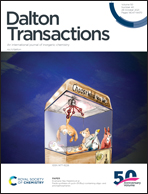Luminescence thermochromism in novel mixed Eu(ii)–Cu(i) iodide†
Abstract
A new mixed Eu(II)–Cu(I) iodide [Eu(DME)4][Cu2I4] (1) was synthesized by the reaction of an organosulphide salt of Eu(II) and CuI in DME media. X-ray analysis revealed that 1 is an ate-complex consisting of Eu(DME)4 dications and tetraiododicuprate dianions. Upon UV light excitation (λ = 365 nm), the compound exhibits intense double-peaked photoluminescence (PL) at 445 and 500 nm. The relative intensity of these peaks changes dramatically when the temperature changes in the range of 180–250 K. To understand the nature of the found PL thermochromism, the structure and time-resolved PL of 1 were studied at various temperatures. The time-resolved PL studies of 1 at various temperatures revealed the presence of two luminescent centers which are excited by the capture of an electron from the conduction band. The ratio of intensities at 445 and 500 nm (R = I445/I500) in the PL spectra of 1 changes by almost two orders of magnitude and the relative sensitivity S (S = (∂R/∂T)/R) exceeds 5% per K in the range of 190–245 K that makes this compound a promising luminescent thermometer for the range where ammonia exists in a liquid state.



 Please wait while we load your content...
Please wait while we load your content...